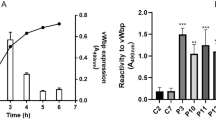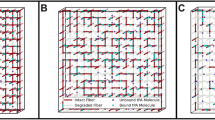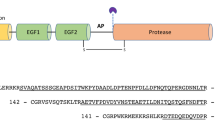Abstract
THE fibrin stabilizing factor (FSF) is a thermolabile plasma protein which in the presence of calcium converts a loosely cross-linked, urea-soluble fibrin clot (fibrin s) into a urea-insoluble gel (fibrin i)1,2. FSF reacts sto-chiometrically with fibrinogen in the latter's conversion to fibrin3 and requires the presence of free sulphydryl groups for its activity4. The recently established enzymatic nature of this factor has led to the suggestion that it be renamed ‘fibrinase’5. Differences in the activity of plasma FSF have been found to be associated with a variety of clinical conditions6. More recently, the occurrence of congenital deficiencies of FSF has been reported and shown to be responsible for abnormal hæmostasis and poor wound healing7,8. In this connexion, it is of interest that fibrin s clots do not support the growth of fibroblast cultures nearly so well as normal plasma clots9, a phenomenon which may in part, at least, be due to the fact that they are less resistant to lysis by plasmin10.
This is a preview of subscription content, access via your institution
Access options
Subscribe to this journal
Receive 51 print issues and online access
$199.00 per year
only $3.90 per issue
Buy this article
- Purchase on Springer Link
- Instant access to full article PDF
Prices may be subject to local taxes which are calculated during checkout
Similar content being viewed by others
References
Laki, K., and Lorand, L., Science, 108, 280 (1948).
Lorand, L., Nature, 166, 694 (1950).
Lorand, L., and Jacobson, Ann, J. Biol. Chem., 230, 421 (1958).
Loewy, A. G., and Edsall, J. T., J. Biol. Chem., 211, 829 (1954).
Loewy, A. G., Dunathan, Katy, Kriel, R., and Wolfinger, jun., H. L., J. Biol. Chem., 236, 2625 (1961).
Lorand, L., and Dickenman, R. C., Proc. Soc. Exp. Biol. and Med., 89, 45 (1955).
Duckert, F. H., Jung, E., and Shmerling, D. H., Thromb. Diath. Hæm., 5, 179 (1960).
Ikkala, E., and Nevanlinna, H. R., Thromb. Diath. Hæm., 7, 567 (1962).
Beck, E., Duckert, F., and Ernst, M., Thromb. Diath. Hæm., 6, 485 (1961).
Bickford, Arthur F., and Sokolow, Maurice, Thromb. Diath. Hæm., 5, 480 (1961).
Lorand, L., Thromb. Diath. Hæm., Supp. 1, 7, 238 (1962).
Author information
Authors and Affiliations
Rights and permissions
About this article
Cite this article
SWIGERT, S., KOPPEL, J. & OLWIN, J. Selective Inactivation of Fibrin Stabilizing Factor Contaminant in Fibrinogen. Nature 198, 797–798 (1963). https://doi.org/10.1038/198797a0
Issue Date:
DOI: https://doi.org/10.1038/198797a0
This article is cited by
Comments
By submitting a comment you agree to abide by our Terms and Community Guidelines. If you find something abusive or that does not comply with our terms or guidelines please flag it as inappropriate.



